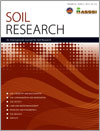There is increasing demand for accurate and reliable data on current soil carbon stocks and how management of different farming enterprises can minimise their carbon footprint. Tasmanian soils have carbon stocks of 49–117 Mg C ha–1 in the upper 0.3 m, which are significantly greater than those in soils on mainland Australia, with the value dependent on soil type and land use. Lower mean annual temperature and higher precipitation in Tasmania provides future opportunities for soil carbon sequestration.

Soil Research
Volume 50 Number 2 2012
SR11272 Estimating mineralisation of organic nitrogen from biosolids and other organic wastes applied to soils in subtropical Australia
Biosolids can supply nitrogen for agricultural crops, but most biosolids nitrogen is in organic form and needs to be mineralised before used by crops. Field studies in subtropical Queensland have shown that the warm and wet conditions resulted in extremely rapid mineralisation rates (40-60% in one crop season) and a rapid accumulation of soil mineral N. Management options include reduced application rates and the coincidence of application with heavy stubble loads in low N concentrations.
SR11331 Effects of rainfall harvesting and mulching technologies on soil water, temperature, and maize yield in Loess Plateau region of China
Common plastic film, corn straw, biodegradable film, and liquid film were applied as mulches in ridge and furrow rainwater harvesting system. The ridge and furrow rainwater harvesting with mulching cultivation could significantly improve soil water and temperature. The ridge was covered with common plastic film, and the furrow was mulched with biodegradable film or straw significantly increased maize yield and net return, so could serve as an effective cultivation pattern.
SR11183 Large-scale spatial variability and distribution of soil organic carbon across the entire Loess Plateau, China
SR11112 Influence of pore size distribution and soil water content on nitrous oxide emissions
Nitrous oxide (N2O) emissions from pastoral soils are strongly influenced by soil aeration, which is affected by soil water content. There are different soil water metrics that can be related to N2O emissions: using laboratory-based intact cores, this study suggested both matric potential and volumetric water content relate well to emissions. Of these two, volumetric water content is considered to be more suitable for estimating N2O emissions from different soils as it is more readily determined.
SR11225 Nitrogen mineralisation from amended and unamended intensively managed tropical andisols and inceptisols
Nitrogen release from organic sources is crucial in nitrogen fertilizer advice systems. There is a lack of knowledge with Indonesian farmers on the nitrogen availability from organic fertilizers and soil organic matter, resulting in massive overfertilization. We have measured mineralization rates from the most important organic resources in intensive vegetable production in West Java, and these results can help to improve nitrogen use efficiency in intensive cropping systems throughout South East Asia.
SR12030 Phosphorus source areas in a dairy catchment in Otago, New Zealand
Phosphorus is an important indicator of water quality and it is important to locate and to understand how different phosphorus sources contribute to losses at a catchment scale. Measurements made of a watering trough and a laneway on a dairy farm revealed greater specific yields of phosphorus compared to the surrounding pasture, representing a substantial source of algal available phosphorus. Future mitigation strategies should target decreasing dissolved phosphorus loss from critical source areas such as laneway areas studied here.
SR11096 Carbon stock in the solum of some coarse-textured soils under secondary forest, grassland fallow, and bare footpath in the derived savanna of south-eastern Nigeria
The West African savanna is one region where the unequalled capacity of the soil to store excess atmospheric carbon can have agricultural, environmental and socio-economic benefits. Carbon stock assessed in the 60-cm layer of sandy soils under common vegetation types with the objective of closing up the glaring information gap in the region followed the order secondary forest > grassland fallow > bare soil. This underscores the need to reduce deforestation rate and annual bush burning in the savanna region.
SR11104 Effects of afforestation with Eucalyptus grandis on soil physicochemical and microbiological properties
We measured the soil fertility following E. grandis afforestation of arable soil to determine whether plantations of Eucalyptus bring about a decrease in soil fertility. We found the restoration of soil fertility; however, most of the properties measured resembled the properties of arable soils and did not resemble the soil of control forests. Thus, reversion of soil properties in the study plantations is likely to require a considerable period of time and long-term research is needed to predict future trends.



